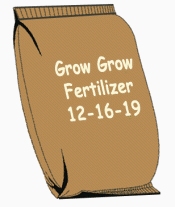As we discussed previously, one of the key differences
between plants and animals is that plants make their own
food through a process called
photosynthesis. In order
to complete this process, the plant must have
chlorophyll, water, heat, light and nutrients in the
proper amounts. If even one of these 5 factors is below
a minimum level for that plant species, no growth will
take place even if the other 4 factors are at perfect
levels.
Generally speaking, the chemical nutrients needed for
plant growth can be divided into two broad categories:
A. Macro-Nutrients - As the term "Macro" implies, these are
nutrients that are needed in relatively large amounts
for plant growth. Can you guess which 3 are at the top
of this list? Ever look at a fertilizer bag and see
numbers such as 12-16-19? Those stand for the percentage
of nitrogen (N),
phosphorus (P) and
potassium
(K) that
are to be found in that bag. Also considered
macro-nutrients are the mineral elements
sulfur (S),
calcium (Ca) and
magnesium (Mg) and the nutrients the
plant gets from water and air, carbon (C), hydrogen (H)
and oxygen (O).
Here is a very brief outline of the role of each of the
macro-nutrients:
-
 Nitrogen
(N) - This is part of the chlorophyll
molecule so it helps to keep the plant green. It is
generally vital for growth of new stems and foliage on
the plant.
Nitrogen is very water soluble and moves
through the ground quickly. Therefore, it is commonly
recommended that it be applied during each growing
season.
Nitrogen
(N) - This is part of the chlorophyll
molecule so it helps to keep the plant green. It is
generally vital for growth of new stems and foliage on
the plant.
Nitrogen is very water soluble and moves
through the ground quickly. Therefore, it is commonly
recommended that it be applied during each growing
season.
-
Phosphorus (P) - Root growth and flowering are two of
the major plant processes that use phosphorus. It is
much less water soluble than nitrogen and, in fact, is
often "tied up" in
clay soils and may build up over the
years. Periodic soil tests will tell you if you even
need to add
phosphorus to your soils.
-
Potassium (K) - This one is vital for seed production
and many other "physiological" functions of the plants.
Potassium's water solubility is between phosphorus and nitrogen
so it too may eventually build up in the soil if it is
applied regularly in your
fertilizers.
-
Sulfur (S) - One of the products of a plant is
protein and sulfur is a vital part of that molecule.
Sulfur
also helps to create an acid environment for the plants
by combining with water to form sulfuric acid in the
soil.
-
Calcium (Ca) - In the soil,
calcium has an impact on
the pH and in the plant is necessary for several of
those "physiological" functions.
-
Magnesium (Mg) - Ever heard of someone recommending
using Epsom salts for your
roses? Well, the science
behind that is that the chemical formula for Epsom salts
is MgSO4 which stands for magnesium sulfate. As a
nutrient,
magnesium is also part of the chlorophyll
molecule so it helps keep the plant nice and green.
Related Articles:
Cation Exchange Capacity -
Fertilizers for the
Landscape -
Inorganic Fertilizers -
Organic Fertilizers
- Fertilizer
Calculations -
Manure as Fertilizer -
Nitrogen Fertilizer -
Phosphorus Fertilizer -
Potassium Fertilizer -
Types of Fertilizer



